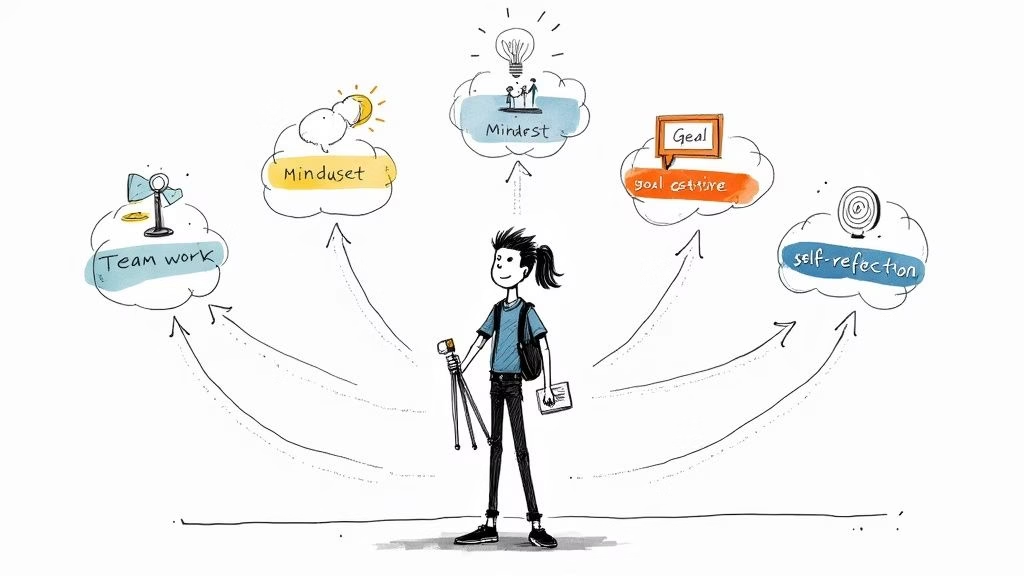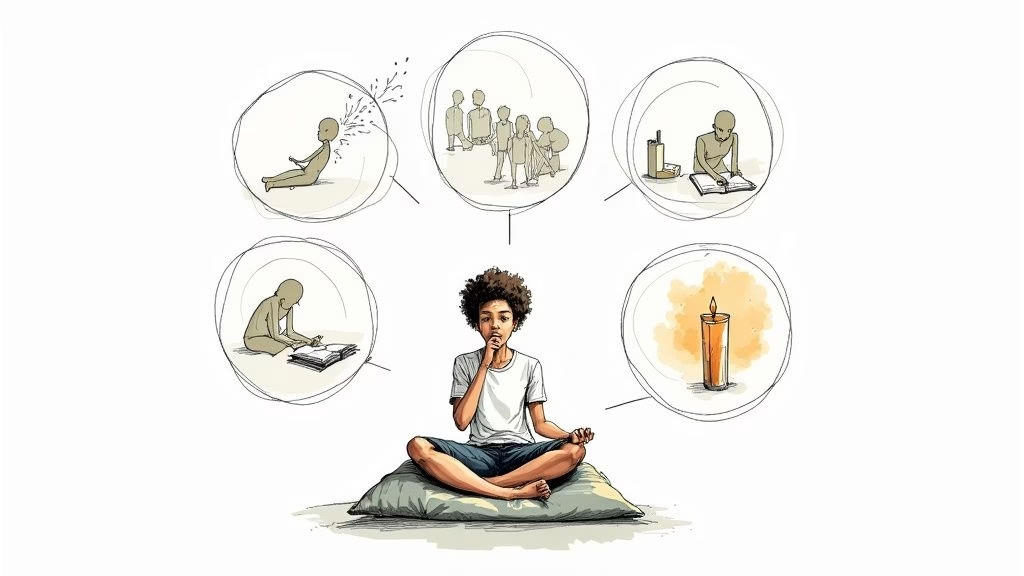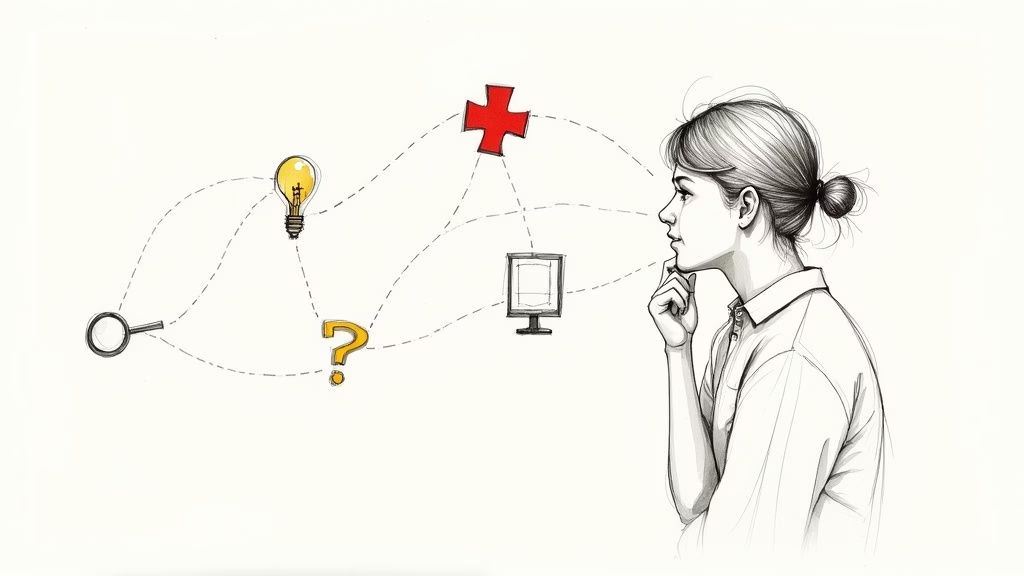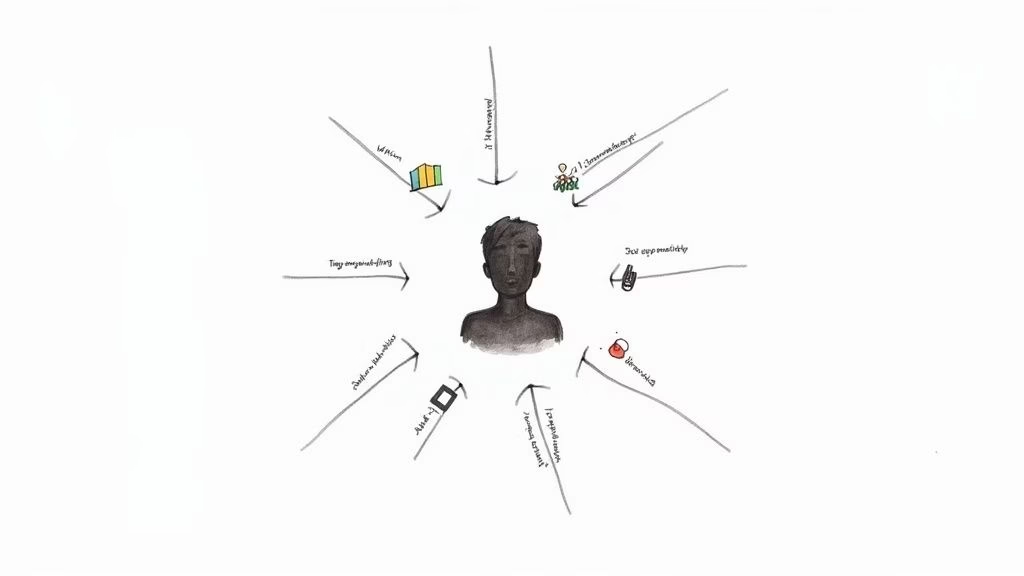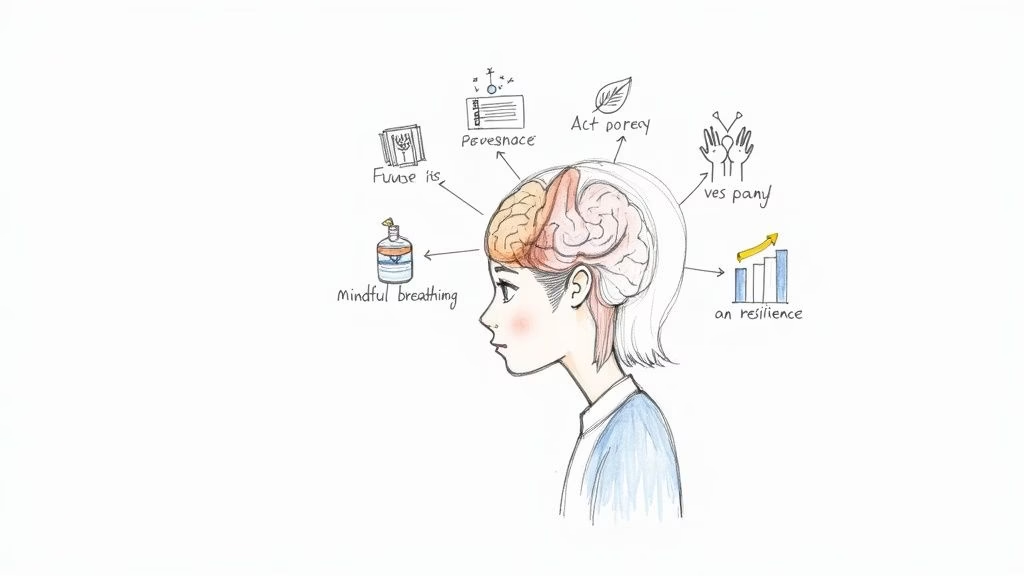When you hear the word "leader," what comes to mind? For a long time, it was the team captain, the class president, or the person who was always the loudest in the room. But that’s an outdated picture.
Leadership today, especially for teens, looks a lot different. It’s less about having a formal title and more about your everyday actions. It’s the friend who really listens when you’re having a rough day, the classmate who organizes a study group before a big test, or the person who stands up for their values, even when it’s not popular.
This is about influence and integrity, not authority. It's a set of skills—like empathy and clear communication—that anyone can build, whether you're a natural extrovert or a thoughtful introvert.
Redefining Leadership For A New Generation
Forget the old-school idea of a leader who just gives orders. Real leadership is built on connection and collaboration.
Think about it. It’s the teammate who encourages everyone after a tough loss, not the one who points fingers. It’s the student who makes sure the quiet kid in the group project gets a chance to share their ideas. These small, consistent actions build the trust and respect that lie at the heart of modern leadership.
This shift is huge because it means leadership is accessible to everyone. You don’t need a badge or a title to start making a difference. Your unique personality and quiet strengths are actually your most powerful tools.
What Really Motivates Young Leaders
Here's something interesting: the traditional climb to the top isn't the main goal for most teens and young adults anymore. The definition of "ambition" has expanded to include personal well-being and doing work that actually feels meaningful.
A massive 2025 Global Gen Z and Millennial Survey from Deloitte found that only 6% of Gen Z said reaching a top leadership position was their number one career goal. What do they prioritize instead? Things like work/life balance and finding a sense of purpose. The full research on these generational shifts really highlights how priorities have changed.
This infographic breaks down some of the key numbers on how teens view leadership and how training impacts their confidence.
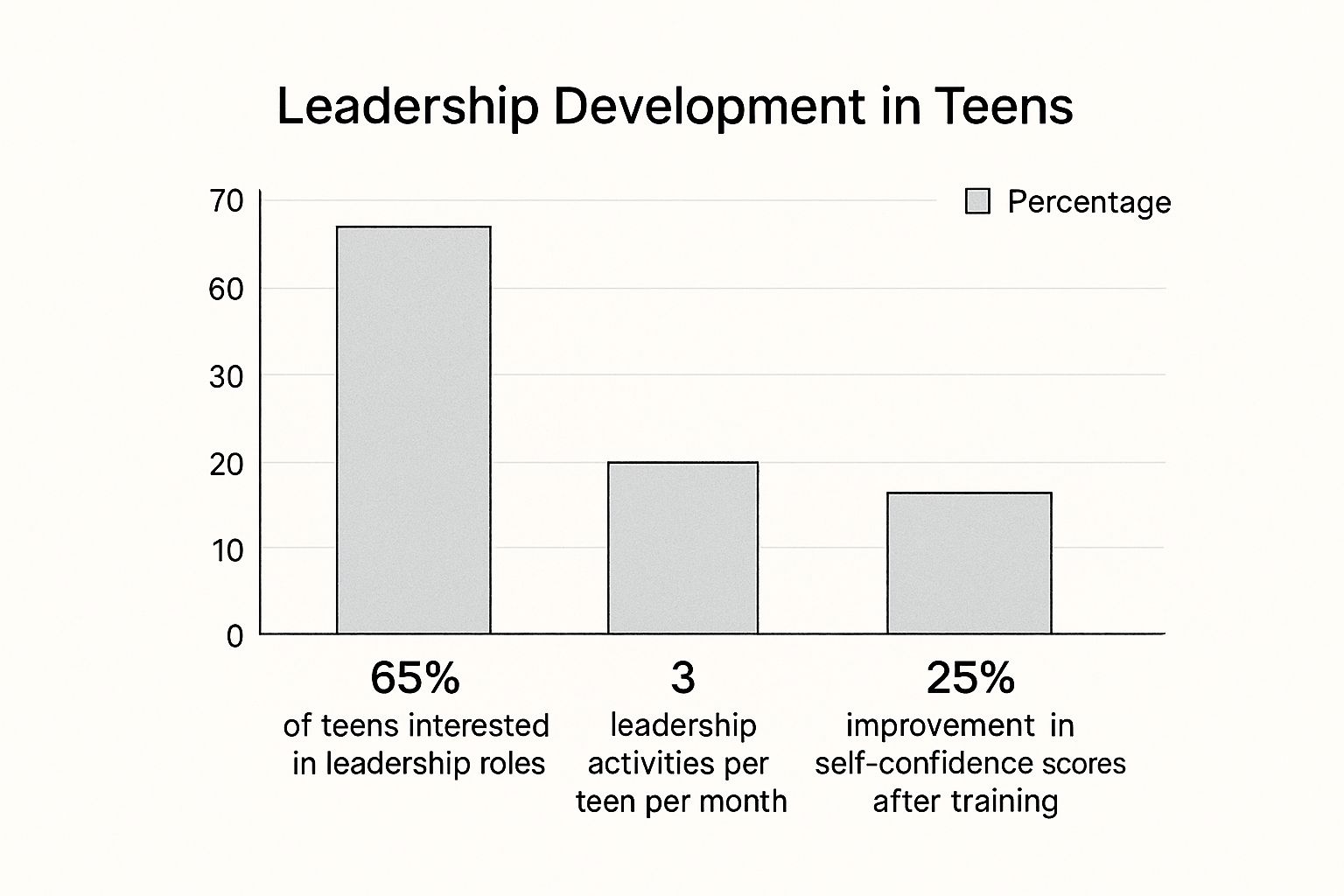
As you can see, the interest is definitely there. The data also confirms that leadership development programs make a real, measurable difference in building confidence.
Let's break down how these ideas have shifted over time. What used to be seen as "strong leadership" is now often viewed as ineffective or out of touch.
The New Rules of Teen Leadership
| Outdated Leadership Myth | Modern Leadership Reality |
|---|---|
| Leaders are born, not made. | Leadership is a set of skills anyone can learn and practice. |
| You need a formal title (e.g., captain, president) to lead. | You can lead from anywhere by influencing and inspiring others. |
| Leaders have all the answers and never show weakness. | Great leaders are vulnerable, ask for help, and learn from mistakes. |
| Leadership is about being loud and in charge. | Leadership is about listening, collaborating, and empowering others. |
| The goal is to reach the top of the ladder. | The goal is to make a meaningful impact and support the group's success. |
This isn't just a minor tweak; it's a fundamental change in what it means to lead. It’s about being authentic and connected, not just being in control.
The Foundation Of Modern Teen Leadership
So, where do you start? It all begins with knowing yourself. Leadership isn’t about pretending to be someone you’re not; it’s about understanding your own strengths and values and learning how to use them.
Focus on building these core pillars:
- Empathy: This is the ability to genuinely understand what someone else is feeling. It's about putting yourself in their shoes before you act or speak.
- Integrity: Simply put, it’s doing the right thing, especially when no one is watching. It’s being honest and staying true to your principles.
- Communication: This is a two-way street. It's about being able to express your own ideas clearly, but just as importantly, it's about actively listening to understand others.
- Resilience: How do you handle it when things go wrong? Resilience is about bouncing back from mistakes and seeing failures not as dead ends, but as opportunities to learn.
By working on these four areas, you’re not just learning to "be a leader." You're building a rock-solid foundation for a more authentic and impactful life, from the classroom to your friendships and your future career.
Building Your Foundation by Overcoming Fear

Often, the biggest thing standing in your way isn't a lack of skill. It’s fear. Fear of failure, social anxiety, and the black hole of procrastination—these are powerful forces that can keep you on the sidelines.
But here’s the secret: leadership isn’t about being fearless. It’s about learning to act despite the fear. Every time you face something that scares you and push through it, you're building a powerful kind of resilience that carries over into every other part of your life.
This process kicks off when you start to reframe what "failure" even means. It’s not a dead end. Every mistake is just a piece of data, teaching you something crucial for your next attempt. Once you start seeing setbacks as part of the learning curve, taking risks becomes a whole lot less terrifying.
From Mountains to Milestones
My own journey drove this lesson home for me. When I first started leading expeditions into the mountains, I was terrified. The weight of being responsible for a team's safety in an unpredictable environment was intense. The fear of making a wrong call was paralyzing.
But pushing through that fear, day after day, built a unique kind of resilience. That experience translated directly to my work leading an engineering team years later. Both scenarios demanded clear communication under pressure, motivating people with different skill sets, and making decisions with incomplete information. The confidence I’d built in the mountains became the bedrock of my professional leadership.
When you overcome a significant fear in one area of your life, it creates a ripple effect. It proves you can handle challenges you once thought were impossible, building a confidence that transfers to school, friendships, and your future career.
Practical Steps to Beat Procrastination and Anxiety
Motivation is unreliable; habits are not. Real progress comes from building systems that work even when you don't feel like it. Procrastination and anxiety often stem from goals feeling too massive to tackle.
Here are a few simple but effective tools to get you moving:
- The 5-Minute Rule: If a task feels overwhelming, commit to working on it for just five minutes. That's it. More often than not, starting is the hardest part. You’ll probably find the momentum to keep going long after those five minutes are up.
- Break It Down: A goal like "ace my final exam" is huge and intimidating. Instead, break it into tiny, doable steps like "review chapter one notes for 15 minutes" or "complete five practice problems." This makes the goal feel approachable instead of terrifying.
- Mindful Breathing: Before a big presentation or a final exam, find a quiet spot. Close your eyes and focus on your breath for one minute. Inhale slowly for four counts, hold for four, and exhale for six. This simple exercise can calm your nervous system and clear your head.
Parenting Tip: Create a home where it’s safe to fail. When your teen tries something and it doesn’t work out, praise their courage for taking the risk. Ask, "What did you learn from this?" instead of focusing on the outcome. This fosters resilience and encourages them to keep trying.
Ultimately, your mental well-being is the engine that powers your ability to lead. Research from a global Deloitte survey shows that 67% of Gen Z with positive mental health feel their work contributes meaningfully to society. That number plummets to just 44% for those struggling with their well-being. This shows just how critical it is to manage fear and anxiety—not just for your own comfort, but for making a real impact.
How Real-World Skills Transfer Anywhere

Leadership isn’t some switch you flip on for a big game or a school project. It's a set of skills that get woven into who you are. The confidence and abilities you build in one corner of your life almost always show up in another, often in ways you’d never expect. This idea of transferable skills is one of the most powerful tools you have.
My own story is a perfect example. Long before I was leading engineering teams, I was guiding groups through treacherous mountain terrain. On a tough climb, you’re not just walking—you're constantly assessing risk, communicating clearly about trail conditions, and motivating people who are tired and starting to doubt themselves. You have to make confident calls with incomplete information, like when the weather suddenly turns or the path disappears.
Years later, I found myself in charge of a complex software project with a crazy deadline. The "terrain" was totally different, but the core challenges felt eerily familiar.
Connecting the Mountain Trail to the Project Timeline
Instead of sizing up a steep, icy trail, I was evaluating project risks and potential delays. Instead of cheering on a tired hiker, I was encouraging a developer who was completely stuck on a piece of code.
It all clicked. The core skills were identical:
- Risk Assessment: On a mountain, it’s watching the clouds and checking trail stability. As an engineer, it’s anticipating budget shortfalls or technical bugs. Both demand that you think ahead and plan for what might go wrong.
- Clear Communication: A misunderstood direction on a narrow ledge is seriously dangerous. A miscommunication about a project requirement can sink weeks of work. The need for clear, calm direction under pressure is universal.
- Team Motivation: Keeping morale high during a sudden downpour is tough. So is keeping a team focused when a project hits an unexpected wall. Real leadership is about building resilience and a shared "we've got this" attitude.
This journey from leading in the mountains to leadership on an engineering team taught me a vital lesson: your hobbies and passions are your best training grounds. The skills you learn coaching a soccer team, organizing a gaming tournament, or leading a volunteer group are the exact same skills that will make you a great leader in your future career.
Practicing for Your Future, Right Now
The trick is to start seeing these connections for yourself. How can you practice being the person you want to become right now, with the goals you currently have?
Start by viewing every experience as a chance to build your leadership toolkit. The courage it takes to speak up in class is the same courage you'll need to pitch an idea in a boardroom. The patience you learn tutoring a friend in math is the same patience required to mentor a new employee. When you start connecting these dots, you’re not just preparing for the future—you’re actively building it, one skill at a time. This is a huge part of developing leadership for teens; it’s about seeing how every little thing you do contributes to the person you’re becoming.
How to Start Practicing Leadership Right Now

Leadership isn't a title you wait for someone to give you. It's a muscle you build through practice, day by day. The best way to start is by looking at the opportunities already around you and turning everyday situations into a personal training ground.
It's about taking small, intentional steps that feel authentic to who you are.
You don’t have to run for class president to be a leader. Real-world practice can be as simple as organizing a study group before a big test or offering to coordinate one small part of a group project. These are low-stakes ways to practice communication, delegation, and responsibility.
Turn Your Passions into Practice
The secret is to find opportunities that connect with what you genuinely care about. When leadership is tied to your interests, it feels rewarding—not like another item on a checklist. So, think about what really gets you fired up, and start there.
Here are a few concrete examples of what this looks like and the skills they build:
- Organize a Park Cleanup: This is project management from start to finish. You’ll learn to coordinate schedules, delegate tasks (who brings trash bags, who contacts the local parks department), and motivate a team toward a common goal.
- Mentor a Younger Student: Offering to help a younger kid with homework or a sport sharpens your empathy and communication. It’s a powerful lesson in patience and explaining complex ideas simply—a cornerstone of great leadership. Exploring the power of mentorship can show you just how life-changing these relationships can be.
- Launch a Niche Club: Love vintage movies, coding, or chess? Start a club. This is a crash course in public speaking (pitching your idea), marketing (recruiting members), and organization (planning meetings and activities).
From Local Action to Global Vision
These small-scale projects do more than just build a resume; they fundamentally change how you think. This hands-on approach actually mirrors a huge shift we're seeing in young leaders across the globe.
The World Economic Forum’s 2025 cohort of Young Global Leaders (YGL) points to a new kind of leadership—one built on collaboration over competition and focused on long-term vision. This new way of leading is all about courage and asking thoughtful questions, which are the exact skills you develop when you tackle a local project you're passionate about. You can learn more about the new generation of changemakers at weforum.org.
Parenting Tip: Encourage your teen to identify one small problem they see at school or in their community. Brainstorm with them—don't direct them—on a simple, actionable first step they could take. This builds a powerful sense of agency and problem-solving.
For teens who might be struggling with motivation or school, these hands-on projects can be a game-changer. They create a clear link between effort and results, which is a great way to fight procrastination.
Likewise, for teen boys and young men who feel pressured to fit into outdated leadership stereotypes, creating their own project gives them a space to lead authentically. Support systems like men's groups can also offer a great environment to explore these new, healthier forms of leadership.
A Practical Toolkit for Teen Mental Health
To be a strong leader for others, you first have to be a strong leader for yourself. That starts with taking your mental and emotional well-being seriously. The pressures of school, social life, and just figuring out the future can feel like a heavy weight, but learning how to manage it is one of the most foundational leadership skills you can build.
Think of your mental health as your internal power source. When it’s charged, you have the energy to chase your goals, stop procrastinating, and show up for your friends and team. But when it's drained, even the smallest tasks can feel impossible.
This section is your personal resource hub, filled with practical tools to help you stay charged. We're going to focus on real strategies for managing stress, building resilience, and finding support when you need it—especially for teen boys and young men, who often face a unique set of pressures.
Simple Meditation and Mindfulness Guide
Meditation isn’t about emptying your mind or achieving some perfect state of zen. It's much simpler than that. It's about learning to observe your thoughts without getting tangled up in them. It’s a powerful tool for dialing down anxiety and sharpening your focus—both critical for any leader.
Here’s a simple way to start, no special equipment needed:
- Find a Quiet Spot: Just sit comfortably for three to five minutes. A chair, your bed, the floor—wherever.
- Focus on Your Breath: Close your eyes and just notice the feeling of your breath. Feel the air come in through your nose, fill your lungs, and then leave your body.
- Gently Redirect: Your mind will wander. That’s 100% normal. When you notice your thoughts drifting to homework, a text message, or what's for dinner, just gently guide your focus back to your breath. Every single time you do this, you're strengthening your mental "focus muscle."
When you're feeling stressed in the moment, practical tools like breathing exercises for anxiety can be a game-changer for calming your mind in just a few minutes.
Resources for Teen Boys and Young Men
It’s crucial to have places where you can talk openly without feeling judged. For teen boys that are struggling, finding a community that actually gets it can change everything. Real leadership involves vulnerability, and these resources for young men are built to support that.
- The Man Cave: This organization runs preventative mental health and emotional intelligence programs for young men. They create safe spaces for real conversation and connection.
- HeadsUpGuys: A fantastic resource focused specifically on supporting men in their fight against depression. It offers practical tips, tools, and personal stories from guys who've been there.
- Local Men's Groups: Many communities have local groups that provide peer support. A quick search online for "young men's support groups near me" or "teen boys groups" can help you find options in your area.
For teens and parents looking for more structured support, exploring stress management techniques for teens can provide a deeper toolkit for navigating all the pressures of life.
Parenting Tip: Try to normalize conversations about mental health at home. Instead of asking, "Is everything okay?"—which usually gets a one-word answer—try something more open-ended like, "What was the most challenging part of your day?" This invites a real conversation, not just a "yes" or "no."
Remember, reaching out for help is a sign of strength and self-awareness. Those are two of the most important qualities any leader can have.
To make things even easier, here’s a quick-reference table with some great tools and organizations that can help.
Mental Wellness Toolkit for Teen Leaders
This table is a curated list of resources, broken down by category, so you can easily find mental health support, mindfulness tools, and peer groups.
| Resource Type | Example/Organization Name | What It Offers |
|---|---|---|
| Mindfulness Apps | Headspace | Guided meditations, sleep stories, and focus exercises designed to reduce stress and improve mental clarity. |
| Crisis Support | Crisis Text Line | Free, 24/7 confidential support via text message for those in crisis. Just text HOME to 741741. |
| Peer Support | The Jed Foundation (JED) | Provides resources and support for teens and young adults to protect emotional health and prevent suicide. |
| Educational Content | Child Mind Institute | Offers expert articles, guides, and resources on teen mental health topics from anxiety to ADHD. |
Having these resources handy means you're never starting from scratch. Whether you need a quick mindfulness break or a serious conversation, help is always available.
Your Leadership Journey Starts Here
This isn't about flipping a switch and becoming a perfect leader overnight. That's not how it works. This is about starting your own journey of growth, one small, real step at a time.
I want you to rethink what "leadership" even means. It’s not a destination or a fancy title. It's a daily practice, built on knowing yourself, taking small but consistent actions, and looking after your own well-being first.
Your unique way of seeing the world is exactly what we need more of. It’s not just a nice thought—global initiatives are finally catching on to how vital youth leadership is for shaping our future.
So, here's my final challenge to you: just pick one thing from this guide that actually felt interesting or doable. And try it this week.
Maybe it’s using the 5-Minute Rule to stop procrastinating on your homework. Maybe it’s finally speaking up in class, or just putting your phone down and truly listening to a friend. You have the power to start leading in your own life, right now. The whole journey just starts with that one first step. What will yours be?
Got Questions? I’ve Got Answers.
Stepping into leadership for the first time brings up a ton of questions. It’s natural. Here are some of the most common ones I hear from teens who are just starting to figure it all out.
“I’m An Introvert. Can I Still Be a Good Leader?”
Absolutely. In fact, some of the best leaders I’ve ever met have been introverts.
Leadership isn’t about who’s the loudest or most outgoing. Introverted leaders often have superpowers that others don't—like being incredible listeners, thoughtful planners, and masters at building deep, one-on-one connections.
Your quiet confidence, empathy, and calm demeanor are huge assets. Don't try to be someone you're not. Instead, lean into what makes you you. Those are your true leadership strengths.
“How Do I Handle Failure When I Try to Lead Something?”
First off, reframe "failure." It’s not a final grade on your abilities; it’s just data. It’s information you can use.
When a project hits a snag or doesn't go as planned, the best leaders don't point fingers. They take a step back and get curious.
Ask your team questions like, “Okay, what did we learn here?” and “What’s one thing we can do differently next time?” When you take responsibility while turning a setback into a learning moment for everyone, you build two of the most important things a leader can have: resilience and trust.
“What’s the Best First Step if I Have Zero Experience?”
Start small. Seriously. The goal is to get a win in a low-stakes environment where you already feel comfortable.
You don't need to run for class president tomorrow. Volunteer to organize one small part of a group project at school. Offer to plan a weekend hangout with your friends. Take on one new responsibility at home and see it through.
Each time you make a decision and follow through, you’re building that leadership muscle. Those small reps will give you the confidence you need to take on bigger and bigger challenges down the road.
Figuring this stuff out is a journey, and you don’t have to walk it alone. Andrew Petrillo Life Coaching is all about giving you the one-on-one support to build real confidence, beat procrastination, and develop the skills that actually matter. If you’re ready to turn your potential into action, let's talk. Schedule a complimentary discovery call today.









